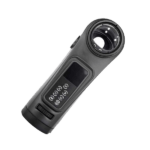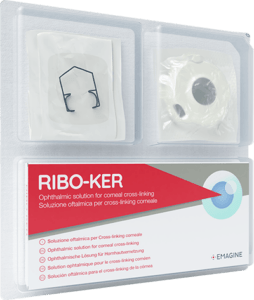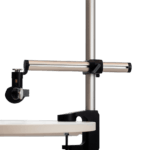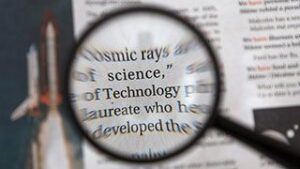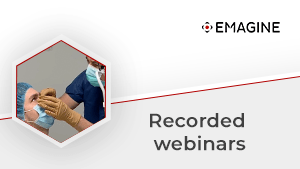The C-eye device
The C-eye device is a portable, battery powered UV irradiation device that can be used to cross-link corneas – either in the OR, or at the slit lamp.
CXL at the slit lamp saves resources. The C-eye device does not rely on costly infrastructure: blocking an OR for this treatment is no longer required.
The C-eye device gives you the freedom to treat either at the slit lamp or in the operating theatre using a stand (sold separately)
The C-eye device can easily be used in different settings, i.e. different clinics.
- Ability to treat at the slit lamp (time saver)
- Delivers all intensities currently used in clinical settings
- Has a thickness-adjusted beam profile
- Fits both on slit lamps and can be mounted conventionally on a stand in the operating theatre..
- Ability to treat at the slit lamp. Saves time and opens opportunities to those colleagues who do not have access to an operating theatre.
- Delivers all intensities currently used in clinical settings
- Has a thickness-adjusted beam profile
- Fits both on slit lamps and can be mounted conventionally on a stand in the operating theatre.
- The patient will not need to be referred to a larger center but can immediately receive treatment with the primary ophthalmologist.
Yes, both the device and the Riboker® are CE-marked.
The C-eye device is compatible with a large number of Haag Streit/ Haag Streit-type slit lamps and with ZEISS/ ZEISS-type slit lamps. You find a constantly growing list of compatible devices here.
Yes: using the optional C-Mount, you may attach the device to a table and perform CXL in the laying position.
Some newer protocols, which are currently under investigation, suggest a beneficial role of pulsed light under certain circumstances. The C-eye device is prepared to deliver pulsed light treatments, once the clinical body of evidence has become more substantial.
One full charge will allow for at least 5 consecutive treatments. The battery life will last at least 500 charging cycles. This is the typical lifespan of a lithium-ion battery. If needed, the battery can be replaced by EMAGine.
Please contact us directly via sales@emagine-eye.com. EMAGine will constantly be updating the distributor list and you can subscribe to our newsletter on our website.
The price for the device and related product line will be determined by your national distributor. Please contact your national distributor directly when the product line becomes available. In the future, you will be able to find your country’s distributor on our website. To get notified of changes, you can subscribe to our newsletter via our website.
Short answer: No.
Long answer: Two types of light might reach the treating physician’s eye:
1) UV-A light: Normally, all UV light is absorbed by the riboflavin when conducting CXL. However, in the case where not all the UV light is absorbed, a small part of the UV light might be reflected directly back as stray light. This stray light would be diffused evenly and everywhere (not in a specific direction). Furthermore, the intensity of the UV light decreases exponentially with the distance to the physian’s eye. The amounts of UV light reaching the physician’s eye are therefore minimal.
2) Fluorescence from excited riboflavin: this light is at 550 nm, outside the range of UV wavelengths and well within the visible light range. In other words: the physician would look at a weak green light.
- Check whether the optics are clean (optics of the recording channel of the C-eye and glass on the C-base) and then repeat the test.
- Make sure that the diameter of irradiation is set to the maximum (12 mm).
https://www.emagine-eye.com/operating-room-classic-cxl-lying-position/The required working distance is 32 mm:
- when treating at the slit lamp, the correct distance is automatically obtained when the ophthalmologist focuses the slit lamp image on the front surface of the cornea
- when treating in the lying position, the C-Focus can be used to easily determine the correct working distance. See the video here.
Our riboflavin: RIBO-KER®
The kit comprises a single-use cap, a speculum and a single vial of Riboker® CE-marked riboflavin.
A major advantage of EMAGine’s RIBO-KER is the fact that it can be used for both epi-on and epi-off CXL and even for PACK-CXL. RIBO-KER was developed by members of EMAGine’s scientific advisory board (Prof. Farhad Hafezi and Prof. Eberhard Spoerl, one of the inventors of CXL)
Yes, you may use RIBO-KER® for both indications.
A major advantage of EMAGine’s RIBO-KER is the fact that it can be used for both epi-on and epi-off CXL and even for PACK-CXL. RIBO-KER was developed by members of EMAGine’s scientific advisory board (Prof. Farhad Hafezi and Prof. Eberhard Spoerl, one of the inventors of CXL)
A major advantage of our “RIBO-KER” is the fact that you can use the same formula for both epi-on and epi-off CXL, and even PACK-CXL.
This depends on the type of treatment
- for all epi-off CXL protocols, a total of 10 minutes is sufficient, applying the drops every 2 minutes.
- for epi-on CXL, a specific dropping timeline will be released once the penetration enhancers are registered for commercial use.
- for PACK-CXL, a total of 10 minutes is also sufficient, applying the drops every 2 minutes.
Bringing CXL technology to the slit lamp is a paradigm shift. Since the distance between the C-eye device and the patient’s eye is shorter than in other CXL devices, we needed to ensure that a consumable protective cap is used for every CXL procedure. To increase patient safety, we have therefore bundled the RIBO-KER® solution with a consumable cap and a light-weight speculum.
Once you scan the kit, you must start UV irradiation within 10 minutes.
It is not necessary to re-apply the riboflavin drops. The concentration of riboflavin within the cornea remains constant for up to one hour, which gives you plenty of time for irradiation. You may want to moisten the cornea every 10 minutes.
“RIBO-KER” has been specifically developed for the C-eye device and was developed by members of EMAGine’s scientific advisory board (Prof. Farhad Hafezi and Prof. Eberhard Spoerl, one of the inventors of CXL). We do not recommend using different riboflavin solutions.
The creation of different riboflavin solutions happened over 2 decades and is not really needed anymore from a scientific standpoint. RIBO-KER can be used for epi-on CXL, epi-off CXL and PACK-CXL.
The customs class of RIBO-KER is: 3004500000
Cross-Linking general
The C-eye device has integrated the sub400 protocol (Hafezi et al., American Journal of Ophthalmology, 2021). With this protocol, the minimal stroll thickness is as little as 200 µm.
We do not recommend administering additional oxygen when using the C-eye device and RIBO-KER and it does not really make sense. It will make the outcome more unpredictable. All protocols have been developed to ensure that there is enough oxygen present within the cornea at all times.
Yes, this is possible, but one should in general avoid pupil dilation prior to CXL.
For all epi-off CXL and PACK-CXL protocols, the total RIBO-KER dripping time is 10 minutes, with drops given every 2 minutes. It is not necessary to reapply RIBO-KER during the procedure.
Epi-on CXL
For epi-on CXL, a specific protocol will be released once the penetration enhancer solution is registered for commercial use.
The penetration enhancers are currently in the process of registration and will be available via EMAGine.
The solution contains a specific composition of a number of different penetration enhancers. This composition, along with a specific way of applying the drops over time, is key to the success of EMAGine’s Epi-On-on CXL
Its is theoretically possible to use iontophoresis for riboflavin soaking in epi-on CXL, but it is unnecessary. EMAGine’s research team optimized the application of penetration enhancers and RIBO-KER to ensure that iontophoresis is not necessary anymore to saturate the corneal stroma with riboflavin.
CXL at the slit lamp
Riboflavin will dissipate due to gravity, but only after one hour. So you have plenty of time.
In a scientific study by our group, riboflavin was applied in the horizontal position on the cornea, and then the cornea was suspended vertically for up to 60 minutes. The riboflavin distribution remained virtually the same, with a difference of only 3% between upper and lower cornea after 1 hour.
CXL at the slit lamp
Focusing is easy: you use the optics of the slit lamp and focus on the epithelium of the corneal apex. Good to know: even when in a defocus of ± 5mm, the increase (when slit lamp too close) and decrease (when slit lamp too far) in intensity will result in a change in irradiation of less than 5%. In other words, when the ophthalmologist focuses the image on the iris plane or on the lid plane, the intensity still is fine.
CXL in the laying position
The C-Focus allows you to easily adjust the correct working distance. See how in our video section.
The slit lamp procedure
- reduces costs, because it can be performed in the doctor’s office,
- the device is portable and can be used in different locations
- enables the ophthalmologist to perform CXL and PACK-CXL even in the standard examination room (please note that even intravitreal injections are nowadays safely performed in the examination room).
PACK-CXL for infectious keratitis
PACK means “PhotoActivated Chromophore for infectious Keratitis”-CXL. The term was defined by our Chief Scientific Officer Prof. Farhad Hafezi and others at the 2013 CXL Experts Meeting in Zurich, Switzerland
Currently (2022), there are more than 200 scientific publications on the topic on PubMed/MEDLINE, including several Phase II studies. A large, prospective randomized Phase III clinical trial was published in 2022: in bacterial, fungal and mixed ulcers of up to 4 mm, a single application of PACK-CXL was just as efficient as medication. PACK-CXL might become a first line therapy in the future.
The C-eye device is the only cross-linking device on the market with the official CE mark allowing for PACK-CXL treatments. So PACK-CXL is no off-label procedure when using the C-eye device with RIBO-KER.
PACK-CXL is still a treatment under investigation, so we are unable to make any suggestions on that matter.
Because the infiltrate/ulcer breaks down the epithelium over the infection, all that needs to be done is to remove debris with a dry sponge, where necessary.
The entire cornea should be instilled with riboflavin and irradiated. This is for two reasons:
1) The RIBO-KER induces the killing effect, but it also acts as a shield from the UV light, by absorbing it. The RIBO-KER in the periphery of the healthy cornea is protecting the corneal endothelium from too much UV irradiation, and
2) The ulcer is bigger than the visible portion of it (compare it to the top of an iceberg). By irradiating the entire cornea, we ensure that the “invisible” parts of the ulcer are treated, too.
Bacteria, including Staphylococcus aureus, both MSSA and MRSA (antibiotic (Methicillin)-sensitive and antibiotic-resistant), Pseudomonas aeruginosa, and Staphylococcus epidermidis: efficacy 80–99%.
Fungi, including Fusarium and Candida albicans: efficacy 60–70%.
The experimental work required to demonstrate this has not been completed. As a correlate:
Solar disinfection (SODIS) is a similar technique to PACK-CXL. In SODIS, water is disinfected using sunlight (energy) and riboflavin. SODIS can kill Herpes simplex virus and acanthamoeba, but the overall total energy is much higher than what we currently use in the cornea.
PACK-CXL certainly helps to kill additional microorganisms and it also increases the resistance of the tissue to digestion. The latter should help keeping the resulting scar smaller than with an antimicrobial treatment alone. More clinical studies are needed to answer this clinical question.
We have tested and published in the laboratory that the efficacy of bacterial killing remains the same when the treatment is accelerated even to 30 mW/cm² for 3 minutes. See here.
Our published multicenter trial was using accelerated protocols.
We recommend not to exceed 30 mW/cm² for now.
No limitations are known.
Daily consultations, continue with standard antimicrobial treatment, treating the open corneal surface.
PACK-CXL is an addition to classic antibiotic treatment. It should be used as early as possible, and it should help to accelerate the time to healing. In particular, PACK-CXL increases the stromal resistance to digestion. This is something an antibiotic does not do, and this might help keeping the final scar minimal.
In a large, prospective multicenter trial published in 2022, a single PACK-CXL treatment was as effective as intense medication over many days, so PACK-CXL might become a standalone treatment some day.
We cannot predict the future, but this might become an option someday.
We currently recommend using PACK-CXL in early infection. In early infection, the cornea usually still is thick enough for CXL, even at the area of infection.
In cases where an advanced ulcer is treated, the aim, also in classic treatment, usually is to “calm” the surface and end up in a quiescent scar. Usually, the underlying endothelium is not functional anymore.
If PACK-CXL is used in these cases, the irradiation might indeed harm the part of the endothelium over the thinnest part of the eye, but it will also kill additional pathogen and help preserve the eye as a structure.
A risk/benefit analysis must be made by the doctor: even when using antibiotics only, a quiescent scar would the best outcome possible. Under these circumstances, the doctor has to decide whether he/she wants to use PACK-CXL to further increase chances of calming the situation.
CXL for keratoconus
- Accelerated 9 mW/cm² for 10 minutes – a solid body of evidence that this setting stops keratoconus progression
- Accelerated 18 mW/cm² for 5 minutes – mixed results so far. Probably better suited for early keratoconus
- Accelerated 30–36 mW/cm² for 3 minutes – has no substantial clinical data published so far. Do not use for KC.
Some countries reimburse for CXL treatment, others do not. Please check your national legislation.
A non-compliant patient that does not allow for irradiation at the slit lamp will probably need irradiation in the lying position. The C-eye device will also have the option to be mounted on a table mount stand, similar to other current CXL devices.
- Intensity = mW/cm²
- Fluence (J/cm²) = Intensity x time (seconds)
- Example: 5.4 J/cm² = 3 mW/cm² x 1800 seconds = 9 mW/cm² x 600 seconds, etc.

